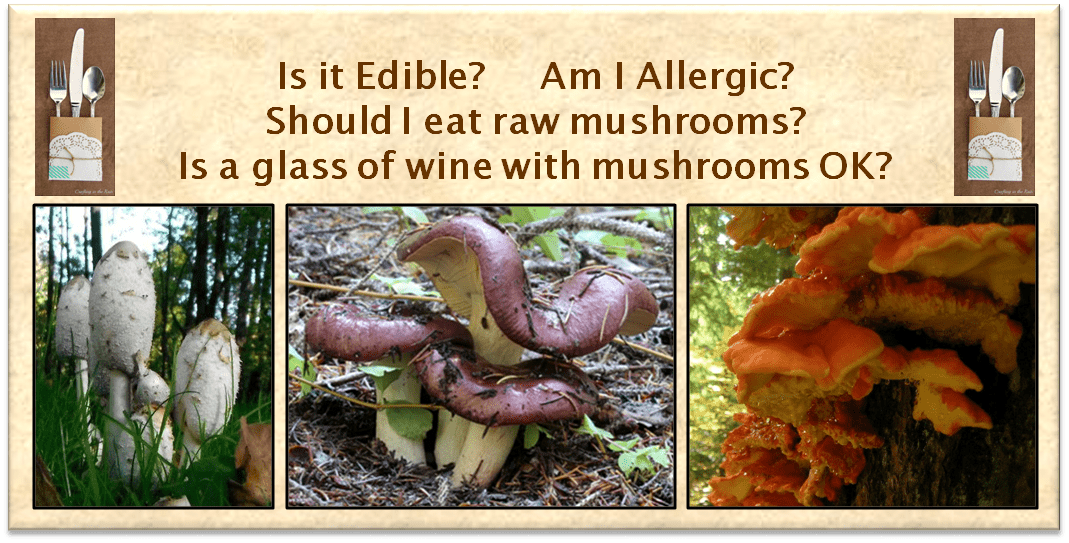
Collecting and Eating Wild Mushrooms
We hope that your interest in fungi will expand beyond foraging for and eating wild mushrooms. But, we do understand this subject has brought many of you to our website and keeping people safe is very important! So, we offer the information below, plus our Mushroom ID help page in hopes you will come to a lifetime of fungi learning and fascination!
Mushroom Season and Deer/Elk Hunting Seasons overlap, so wear bright clothing.
There are many species of delicious wild mushrooms which grow in our area, and learning to find and enjoy these gifts is satisfying on many levels. However, you should exercise caution as there are many species that are not edible and may cause various levels of discomfort if eaten. There are also a handful that contain potent toxins that can cause permanent organ damage or even death. To get started down the mycophile path, please follow these mushroom foraging safety guidelines. And always remember, “when in doubt, throw it out!”
This 10 minute video covers all of the basics talked about in our Edibility Guidelines below, plus more!

Edibility Guidelines
Accurately identify every mushroom you plan to eat
Despite folklore to the contrary, there are no simple guidelines which will separate edibles from those that are not. You must assume the responsibility to identify all wild mushrooms you collect to eat with 100% confidence. Many edible species have toxic look-alikes; learn what these are, and don’t just rely only on photographs or drawings!
Only collect and eat fresh mushrooms
You wouldn’t eat moldy or rotting produce from the grocery store — the same should be true for wild mushrooms.
Do not collect in contaminated areas
Be aware of where you are collecting your edibles. Mushrooms can readily pick up chemicals from the environment. Never consume edible species from a lawn or area where fertilizers or pesticides may be present. Avoid collecting along busy roads or anywhere near old dump sites. Do not eat fungi growing on ornamental trees. In some cases, toxins in the wood may seep into fungal tissue. Only eat fresh mushrooms.
Don’t eat raw mushrooms

This applies to all mushrooms, even store bought cultivated mushrooms. Thorough cooking provides improved digestibility, flavor, available nutrition and the elimination of some potentially harmful substances. However, be aware that cooking will not eliminate all types of toxins and will not make poisonous mushrooms edible.
The new species rule – 2 teaspoons
When trying a mushroom species for the first time, eat no more than two cooked teaspoons of one species, then wait 24 hours before eating any more of that species or trying another new species.
Just as some people are allergic to peanuts, shrimp, wheat, or dairy; you can also be allergic to some species of mushrooms. If you are eating a new species for the first time, and you eat more than one species and have a reaction you won’t know which species you are allergic to. So sample new species one at a time (one per day maximum), and for the first sample, limit to two teaspoons. Just in case you do start to feel unwell and want to confirm the identification later; keep a whole, raw sample of the mushroom in your refrigerator.
Do not consume alcohol when trying a mushroom for the first time

Wait until you are sure you are not allergic to a particular species before having it with wine or beer. When consuming a new mushroom species, the presence of alcohol may produce stronger allergic reactions. Also, one species of the genus Coprinus reacts with alcohol resulting in uncomfortable symptoms. Before eating any shaggy mane (Coprinus comatus) with alcohol, learn about the ones that cause this reaction.
Find tips on gear for foraging on the CMS field trips page
A Guide to Outdoor Safety and Health
Enjoy!
Having an understanding and appreciation of the variety and beauty that surrounds us in the fungal world will enrich your diet and your life.
